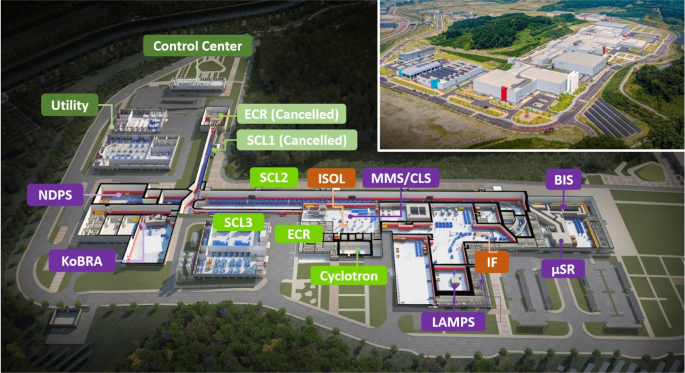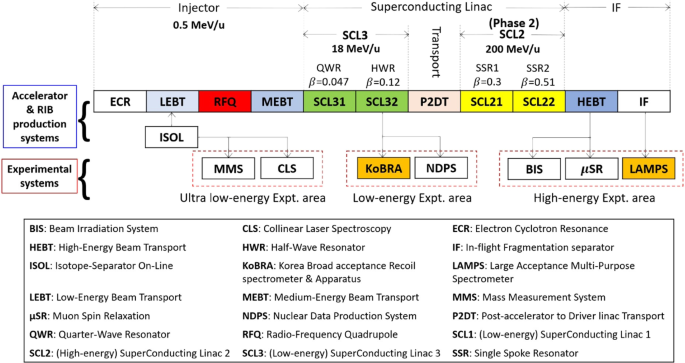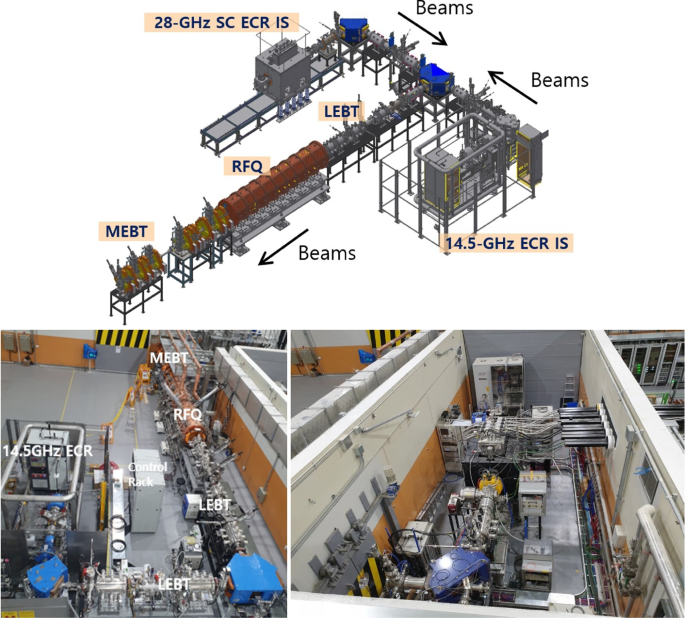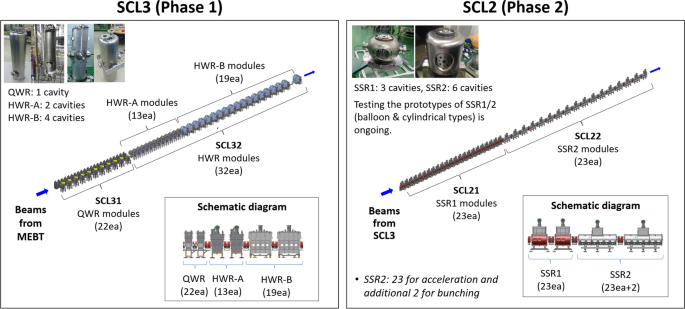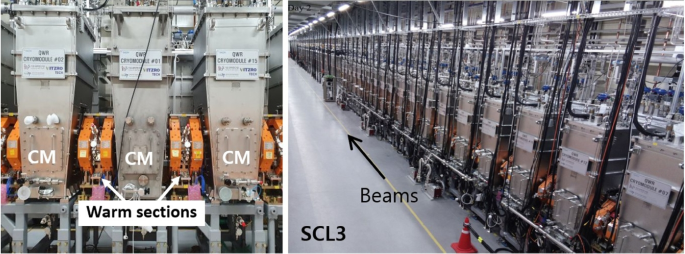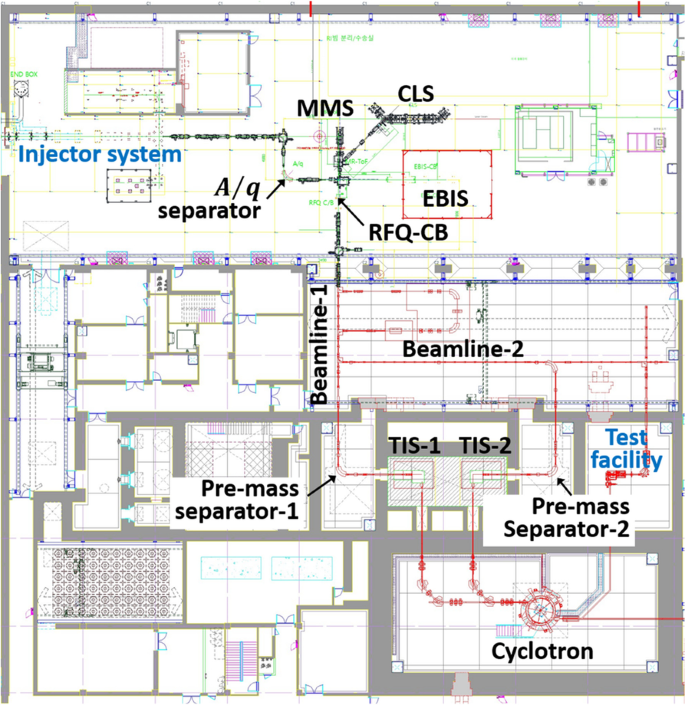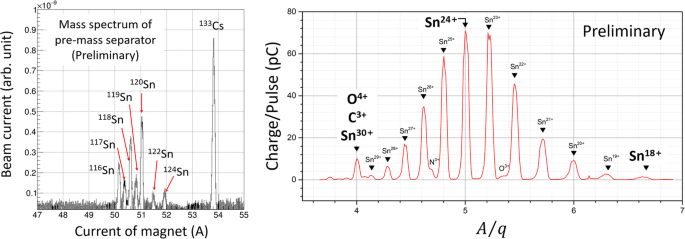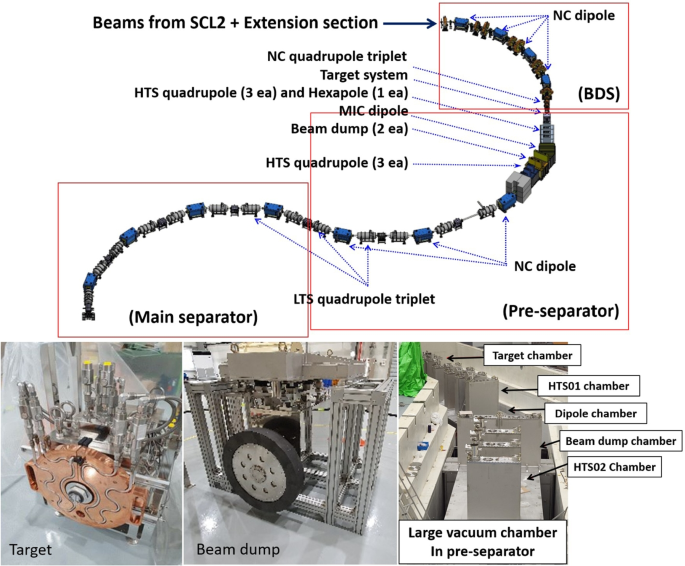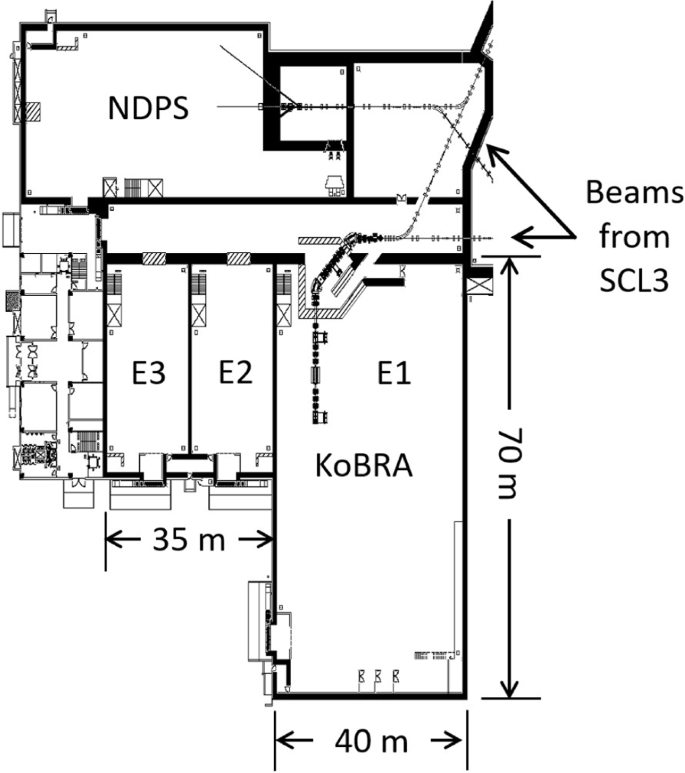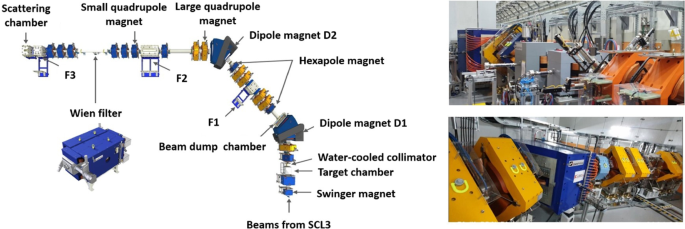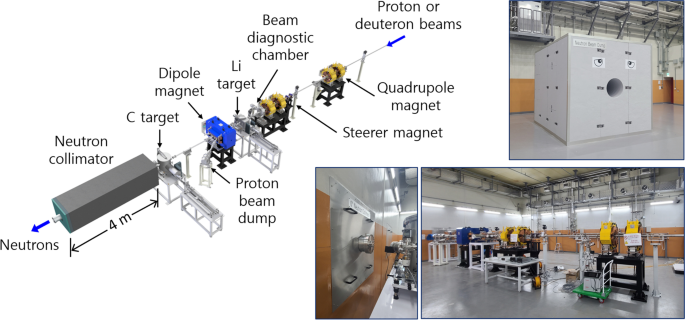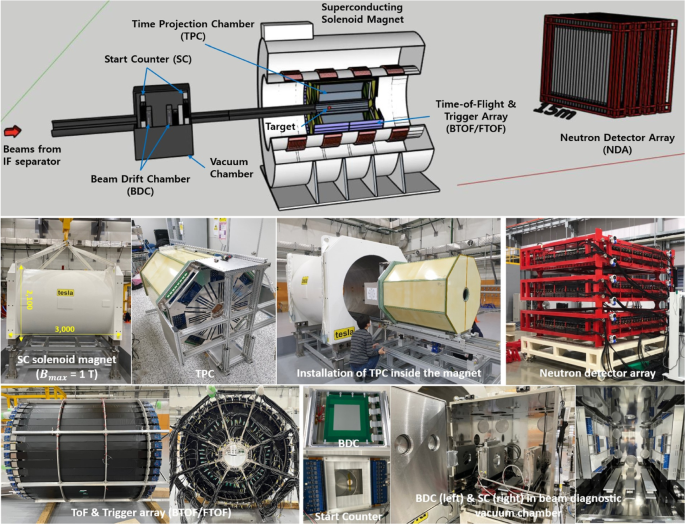4.1 KoBRA
KoBRA is a dedicated spectrometer for studying nuclear structure and astrophysics at low energies below \(\sim\)40 MeV/u [5, 6]. Figure 11 shows the low-energy experimental halls. Presently, the two rooms are used for setting up the KoBRA and NDPS systems, respectively, and the other two rooms (E2 and E3) are reserved for future experiments. The schematic of the KoBRA setup is displayed in the left panel of Fig. 12. The right side of Fig. 12 shows two recent images for the production-target-chamber (F0) area on top and the dispersive focus (F1) area at the bottom. KoBRA consists of a swinger magnet right before the production target chamber, the two curved-edge bending magnets (D1 and D2) to minimize the high-order aberrations up to the fourth order with two hexapole magnets, and fifteen quadrupole magnets. The swinger magnet bends the beam direction up to 12\(^{\circ }\) for the rigidity of 3 Tm. The horizontal and vertical angular acceptances are 80 and 200 mrad, respectively, and the momentum acceptance is 8%.
The magnetic rigidity of RIBs can be analyzed at F1. The momentum and maximum mass resolving powers are 2100 and 750, respectively, for the horizontal beam size of 2 mm. Either homogeneous or curved degrader can be inserted at F1 to increase the beam purification. There are two double achromatic foci (F2 and F3) located downstream of F1. The installation of the KoBRA components was completed in June 2021 except for the Wien filter, which will be installed between F2 and F3 in 2023 to cause a mass dispersion at F3.
The beam transportation test was performed by installing the \(^{241}\)Am \(\alpha\) source at F0. The magnetic rigidities of \(\alpha\) particles emitted from the source were analyzed by using the position information at F1 for each particle. The position at F1 was measured by the large area PPAC. The relative abundances of \(\alpha\)’s at three different energies (5.388, 5.442, and 5.486 MeV) and the transversal distributions at F1, F2, and F3 were consistent with the Monte−Carlo simulations, confirming the momentum resolving power at F1.
The startup plan for KoBRA is to experiment with the first commissioning \(^{40}\)Ar beams at 25 MeV/u in 2023. RIBs, e.g., \(^{32}\)Mg, will be produced by bombarding the \(^{40}\)Ar beams on a graphite production target at F0, and the subsequent part of the magnetic spectrometer will select the desired RIBs for the experiments. However, the true strength of KoBRA can be recognized when ISOL provides exotic nuclei with high purity. For the experiments at KoBRA, several detector systems, such as the high-resolution \(\gamma\) detector system, Si detectors, and active-target time-projection chamber (AT-TPC), are being prepared.
In the early operational stage of RAON, these detectors will be used for several nuclear astrophysics and structure experiments, for example, the proton-induced fusion evaporation of neutron-deficient nuclei, fusion reactions related to stellar evolution, a lifetime of isotopes near doubly magic N = Z nuclei, fusion-evaporation reactions of three neutrons for mirror energy differences (MEDs) for T = 3/2 mirror pair nuclei, optical model potential studies using stable beams, spectroscopy of proton, neutron and \(\alpha\) emitters, measurement of RI production cross-section, and decay spectroscopy using fast-timing measurement.
4.2 NDPS
NDPS is a dedicated system for nuclear data production and other industrial applications. NDPS provides both white neutrons and monoenergetic pulsed neutrons. For white neutrons, the deuteron beams at 49 MeV/u bombard a thick graphite target. For monoenergetic neutrons, the proton beams at 83 MeV bombard a thin Li target. The NDPS system consists of two production target chambers, four quadrupoles and one dipole magnet, a proton beam dump for monoenergetic neutrons, and a 4-m-long neutron collimator. Figure 13 shows the schematic of the NDPS system with two images of the target room and neutron collimator. The neutron beam dump, which is only a concrete block with a thickness of \(\sim\)1 m, is placed approximately 35 m downstream from the exit of the neutron collimator.
4.3 LAMPS
Figure 14 shows the high-energy experimental halls at RAON. One of the rooms is used for LAMPS, which is presently the only detector system for nuclear physics in high-energy experimental halls, and another room is reserved for future experiments, such as the zero-degree spectrometer (ZDS). LAMPS was originally designed to investigate the nuclear equation of state (EoS) and the symmetry energy at the supra-saturation baryon densities; nonetheless, it can also be useful for studying the nuclear structure. LAMPS accepts high-intensity and high-energy RIBs, for example, \(^{132}\)Sn beams at 250 MeV/u with intensity as large as 10\(^{8}\) pps.
The top panel of Fig. 15 shows the schematic of the LAMPS system [7, 8]. It consists of a beam diagnostic chamber and an almost azimuthally symmetric charged particle tracking system surrounded by a superconducting solenoid with a maximum field strength of 1 T. In addition, the neutron detector array is located in the forward region. In the beam diagnostic vacuum chamber, the starting counter (SC) coupled with movable veto paddles and beam drift chambers (BDC) are placed. For the charged particle tracking system, the time-projection chamber (TPC) consisting of eight octant sectors and the barrel and forward Time-of-Flight arrays (BToF and FToF, respectively) are used. Most of the detector components and a magnet are developed, fabricated, and assembled. The machine commissioning of the integrated LAMPS system including the LAMPS trigger and data acquisition system is foreseen by the end of 2022.
Although the development and construction of SCL2 have been postponed to the second phase, the LAMPS Collaboration is planning the physics program, for example, the isospin transport phenomenon and nuclear symmetry energy, the skin structure of the neutron-rich nuclei, and the measurement of the quasi-free scattering cross sections with the neutron-rich beams.


